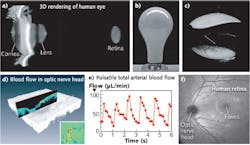Lauded for its ability to noninvasively image to depths of several millimeters in medical and industrial applications, optical coherence tomography (OCT) is operating faster and imaging longer distances with the help of vertical-cavity surface-emitting laser (VCSEL) sources.1 Newly developed wavelength-tunable VCSELs are extending the OCT imaging range—while enabling ultrahigh imaging speed—potentially to tens-of-centimeters to meter-depth ranges.
In mid-2011, Laser Focus World reported on 760-kHz-rate OCT imaging using a 1310 nm, singlemode, microelectromechanical systems (MEMS)-based tunable VCSEL with a 110 nm tuning range. In late 2012, the MEMS-VCSEL wavelength tuning range was extended to 150 nm. Now, the same team of researchers from Thorlabs (Newton, NJ), Praevium Research (Santa Barbara, CA), and the Massachusetts Institute of Technology (MIT; Cambridge, MA), with support from the National Institutes of Health, has developed and demonstrated 1060 nm MEMS-VCSELs for OCT imaging at ultrahigh speeds and over record long distances. The extended depth range enables applications such as full-eye-length imaging and characterization of large, high-aspect-ratio manufactured parts. The high phase stability achieved by MEMS-VCSELs also enables functional imaging such as Doppler OCT.
Full-eye-length and blood-flow imaging
The tunable VCSELs for swept-source OCT are important because 1060 nm wavelengths pass through the water in the vitreous of the eye, are less affected by cataracts, and penetrate deep behind retinal tissue. The record-long coherence length of the VCSEL enables 3D volumetric images of the anterior eye with an axial eye length measurement in a single acquisition, promising to provide doctors with additional information about anterior eye disease and to assist in prescribing intraocular lens implants for cataract surgery.2
A further advantage is that VCSEL swept-source OCT is less prone to fringe wash-out effects due to beam scanning than the spectral Fourier-domain OCT alternative used in most clinics. Using a VCSEL swept light source in a prototype imaging instrument operating at a fast 400 kHz axial scan rate enables detection of rapid blood flow with an axial velocity range of ±80 mm/s. The high axial scan rate also enables collection of multiple 3D volumes per cardiac cycle for characterization of blood flow and “pulsatility” (variation in velocity of blood flow) in the eye.3 The same VCSEL can be run at a 1.2 MHz axial scan rate to obtain large-area and comprehensive OCT data sets of the retina.
The depth range of swept-source OCT imaging depends on the laser coherence length, sweep repetition rate, wavelength tuning range, and detection bandwidth. As professor James G. Fujimoto at MIT describes, “The VCSEL is significantly better than previous swept light sources demonstrated for OCT because the VCSEL tunes a single longitudinal mode without mode-hopping, achieving an extremely long coherence length. While most OCT light sources can only image over a few millimeters’ range, the VCSEL can image over depth ranges spanning tens of centimeters to greater than a meter.”
The team has recently performed 3D surface profiling of a machined aluminum optical post over a depth range of 15.2 cm and nondestructive 3D imaging inside a light bulb (see figure). Both examples are representative of operations useful for assembly, inspection, and quality control in manufacturing.
REFERENCES
1. B. Potsaid, “MEMS Tunable VCSEL Technology for Ultrahigh-Speed OCT,” SPIE Photonics West Hot Topics session (Feb. 2, 2013).
2. I. Grulkowski et al., Opt. Lett., 38, 5, 673–675 (Mar. 1, 2013).
3. W. Choi et al., Opt. Lett., 38, 3, 338–340 (Feb. 1, 2013).

